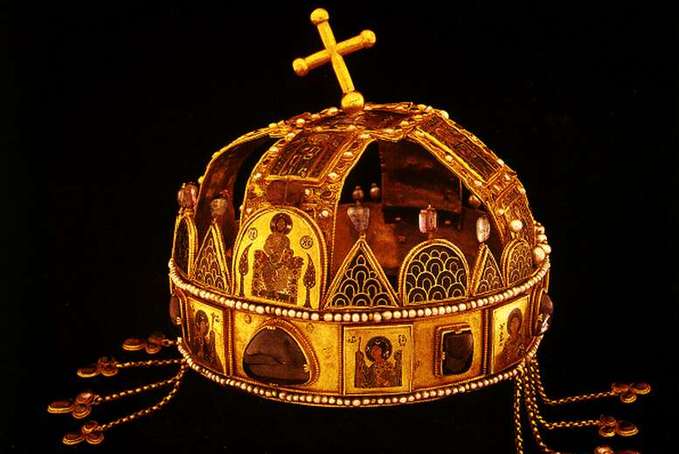László Németh, - not the same as the author of the "Revolution of Quality" - points out in his detailed study, agreeing with other authors: "during the conversion of the Hungarians, the cult of the ancient goddess facilitated the selection of the Mother of God in the Christian sense, the Blessed Virgin".
"The veneration of Mary in the Hungarian Catholic revival took on a specific, normative character in accordance with the contemporary needs of the Hungarian soul. Sometimes we also find a national color in the Marian veneration of other nations, but this has not solidified in the form of the Hungarian Regnum Marianum."
He mentions the legend where in the plan of the Holy Virgin, "Prince Géza's unborn child will play the main role. According to the legend... the Holy Virgin appears to Géza and warns him about the vocation of the unborn child .
the Protestant Gáspár Heltai, the Virgin Mary was replaced by God himself - in the Hungarian translation of Bonfini's text following the Hartvik legend. Our country and our nation were under the protection of the Holy Virgin at all times by "natural law", says the author, and then continues: "... the offering of the country became the final and most significant, so to speak, legal contract between the Blessed Virgin and the Hungarian people".
Németh mentions - to characterize the Catholic-Protestant contrast - István Magyari's book, which in 1602 calls the papists innovators, who introduced, among other things, "the meeting of the feast of the Blessed Virgin and several Saints". He states the sin of idolatry, for which the Lord scourges the Hungarians. Let's see how the author writes:
"The veneration of Mary permeated both St. Stephen's spiritual life and his activities as a governor. His oldest life story, the Legenda Maior, narrates that the holy king went to war against the rebel Koppány in the name of the Holy Virgin, he appealed to Mary for help against Konrád's attack, but in the same way she forgave him in the name of the Holy Virgin for the harm done to him . His reverence for Mary stands out from the large number of dioceses and monasteries dedicated to the Mother of God. To connect the great family of Christian Hungarians with the person of Mary, he liked to call his people haereditas Mariae, familia Mariana, the household and heritage of the Holy Virgin.
This aspiration of his was especially expressed in a sublime form when he had to leave the tender seedling of Christianity and the Hungarian kingdom without a suitable successor due to the unexpected death of Saint Imre. Amidst the waves of uncertainty, he turned to the Blessed Virgin as the only sure refuge: "Queen of Heaven, - he prays to her - with my last prayer, I entrust the bishops and clergy of the holy Church, the princes of the kingdom and the people to your protection".
King Saint István is therefore the first custodian of the intimate relationship between Hungarians and the Holy Virgin. During later times, as the first rex, Marianus was in the favor of the Hungarians. Precisely because he created such an ideal and solid state with his deep faith, statesmanlike wisdom, knowledge of the soul of his people, and a clear understanding of the situation, and was able to defend his state against external and internal enemies with his ability as a general, he stood as an ideal for his successors during the following centuries. His ideal state was the Hungarian kingdom under the special protection of the Blessed Virgin, in whose bond the Christian Hungarian people could achieve the reward of earthly prosperity and heavenly happiness by progressing on the path of moral perfection. This ideal, which appeared first as a pious idea and then as a state ideal, forms the root of the Regnum Marianum that has developed over the centuries. Our medieval kings, as in other ways, also set St. István as an ideal before them.
Saint László is the ideal of the medieval knight, he is the culmination of the work of the first holy king in building churches, founding bishoprics and abbeys, he is also the chosen knight of the Virgin Mary, another important royal figure of the medieval Regnum Marianum.
From the point of view of the Hungarian Marian cult of the Middle Ages, we can mention the Council of Szabolcs, which ordered three holidays in honor of the Holy Virgin, Gertyaszentelő, Assumption of the Blessed Virgin Mary, and the Day of the Virgin, which was spread in Western countries by Fulbert, Bishop of Chartres, a contemporary of Saint Stephen. The influence of the Cluny reform can still be seen in the time of Kings Géza, Szent László and Kálmán. Kálmán's period in Marian history is also of special importance because the Hartvik legend was written in this period and became a rounded description of St. Stephen's devotion to Mary, which was so often referred to in later times.
... So the baroque Catholic world understood the offer of the country as a legal fact, a contract, in which the contracting parties are the Mother of God and the Hungarian people. The nation was represented by Szent István. According to the concept, rights and obligations were assigned to each contracting party. When Saint Stephen offered his country, his young Christian nation and his Crown to Mary, he handed over with the Crown all the sovereign rights that the Holy Crown, according to the thinking of the time, united in itself. The Blessed Virgin Mary is a real queen, and even became more than a queen in the eyes of the Hungarian faithful. He won the right to manage all the affairs of the Hungarian people, even to choose the person of the king , as we will see later. The mighty Virgin, glorified by her holy Son and enthroned beside herself, had such power that she was able to govern her kingdom.”
In the five-volume Magyar Történet (fourth volume), Gyula Szekfű lists the five legal principles of the Regnum Marianum, such as
- the king can only be Catholic,
- the king should rule with the help of the council of lords,
- the king should stay in the country,
- the king should keep the country free,
- let the king swear to the constitution.
This is an optimistic, self-conscious view of Hungarian history. "The spirit of order, which also recognizes the royal power, religious feeling, and the projection of today's ideals into the past... make up the public law content of the country of Regnum Marianum."
This doctrine also served to moderate the royal power and prevent the absolutism already existing in the West by reviving and renovating the Civitas Dei of St. Augustine, proclaiming conditions in the midst of which the citizens of the Civitas Dei (God's country) can easily achieve eternal happiness .












